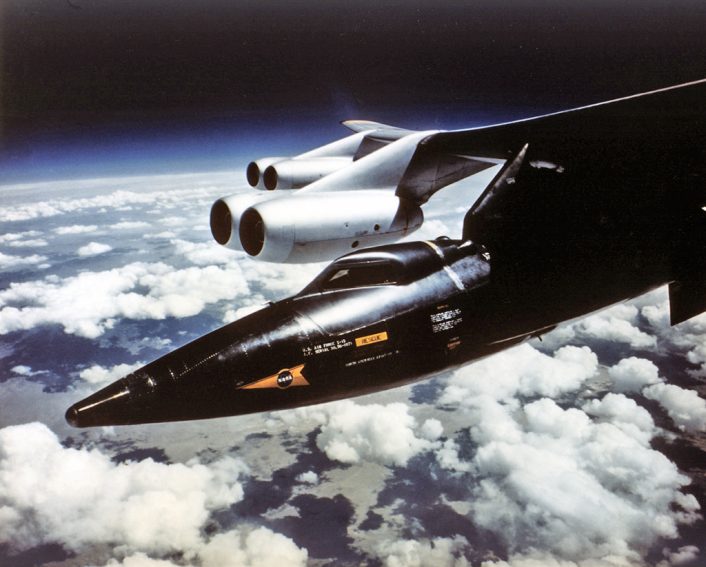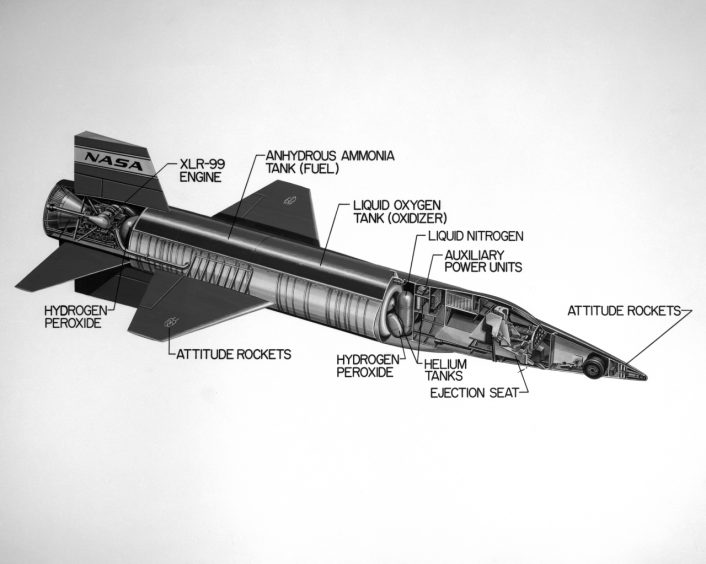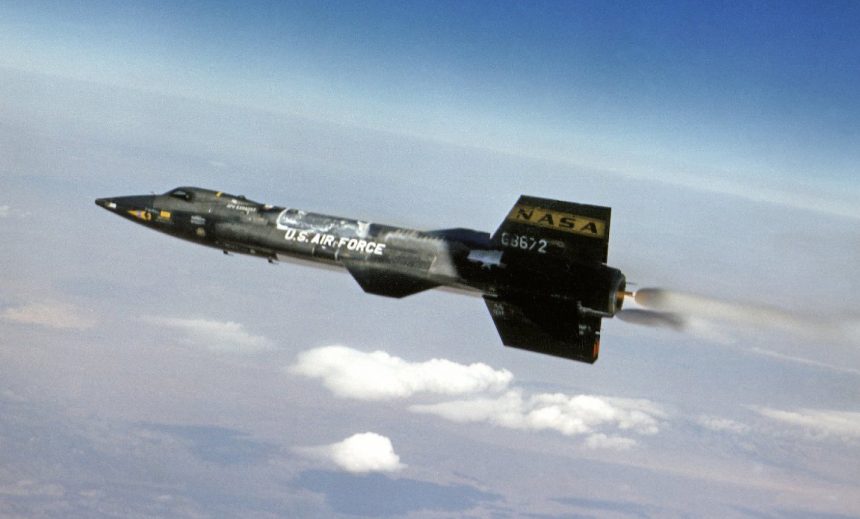U.S. Air Force test pilot Maj. Michael J. Adams was killed during X-15 Flight 191 on Nov. 15, 1967.
The North American X-15 was a hypersonic rocket-powered aircraft 50 ft long with a wingspan of 22 ft. operated by the United States Air Force and the National Aeronautics and Space Administration as part of the X-plane series of experimental aircraft in the 1960s.
It was a missile-shaped vehicle with an unusual wedge-shaped vertical tail, thin stubby wings, and unique side fairings that extended along the side of the fuselage. It was powered by the XLR-99 rocket engine, manufactured by Thiokol Chemical Corp., pilot-controlled and capable of developing 57,000 lb of thrust.
The aircraft was brought to the launch altitude of 45,000 feet by a NASA B-52 “mothership” then air dropped to that the rocket plane would have enough fuel to reach its high speed and altitude test points. Depending on the mission, the rocket engine provided thrust for the first 80 to 120 sec of flight. The remainder of the normal 10 to 11 min. flight was powerless and ended with a 200-mph glide landing.

The X-15 was capable of climbing to the edge of space at an altitude in excess of 300,000 feet at speed of more than 4,500 miles per hour (+7,270 km/h). Actually, the target altitude for X-15 flights was set at 360,000 feet because there were concerns about the reentry from 400,000 feet, that was the maximum altitude the rocket plane was theoretically able to reach.
Two types of flight profiles were used during test flights depending on the purposes of the mission: a high-altitude flight plan that called for the pilot to maintain a steep rate of climb, or a speed profile that called for the pilot to push over and maintain a level altitude.
For flight in the dense air of the usable atmosphere, the X-15 used conventional aerodynamic controls but to maneuver in the thin air outside of the appreciable Earth’s atmosphere, where flight control surfaces were useless, the X-15 used a reaction control system (RCS) made of hydrogen peroxide thrust rockets. Those located on the nose of the aircraft provided pitch and yaw control; those on the wings provided roll control. A similar system was used on the Space Shuttle Orbiter, decades later: indeed, experience and data gathered from the X-15 program contributed to the development of the Mercury, Gemini, Apollo and Space Shuttle manned spaceflight programs.

1/20/62
Needless to say, handling the rocket-powered aircraft at the edge of space was particularly challenging.
X-15-3 (56-6672) made 65 flights during the program. It reached attaining a top speed of Mach 5.65 and a maximum altitude of 354,200 feet.
Official records say that only 10 of the 12 X-15 pilots flew Ship #3; eight of them earned their astronaut wings during the program (in fact, U.S. Air Force pilots who flew the X-15 to altitudes above 50 miles all received Astronaut Wings): Robert White, Joseph Walker, Robert Rushworth, John “Jack” McKay, Joseph Engle, William “Pete” Knight, William Dana, and Michael Adams all earned their astronaut wings in Ship #3.
Out of three X-15s built by North American for the program, Ship #3 is the only X-15 that has not survived, as it was lost on Nov. 15, 1967.
X-15-1, serial number 56-6670, is now located at the National Air and Space museum, Washington DC. North American X-15A-2, serial number 56-6671, is at the United States Air Force Museum, Wright-Patterson AFB, Ohio.
Here’s the story of that last mission:
On 15 November 1967, Ship #3 was launched over Delamar Lake, Nevada with Maj. Michael J. Adams at the controls. The vehicle soon reached a speed of Mach 5.2, and a peak altitude of 266,000 feet.
During the climb, an electrical disturbance degraded the aircraft’s controllability. Ship #3 began a slow drift in heading, which soon became a spin. Adams radioed that the X-15 “seems squirrelly” and then said “I’m in a spin.”
Through some combination of pilot technique and basic aerodynamic stability, Adams recovered from the spin and entered an inverted Mach 4.7 dive. As the X-15 plummeted into the increasingly thicker atmosphere, the Honeywell adaptive flight control system caused the vehicle to begin oscillating. As the pitching motion increased, aerodynamic forces finally broke the aircraft into several major pieces.
Adams was killed when the forward fuselage impacted the desert. This was the only fatal accident during the entire X-15 program. The canopy from Ship #3, recovered during the original search in 1967, is displayed at the San Diego Aerospace Museum, San Diego, California.
Parts of the crashed X-15-3, serial number 56-6672, recovered in 1992 by Peter Merlin and Tony Moore (The X-Hunters) are on display at the Air Force Flight Test Center Museum at Edwards.
According to NASA, the X-15s made a total of 199 flights over a period of nearly 10 years (from June 1959 to Oct. 1968) and set world’s unofficial speed and altitude records of 4,520 miles per hour or Mach 6.7 (set by Ship #2) and 354,200 feet (set by Ship #3).









